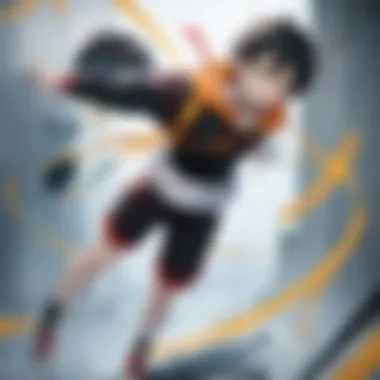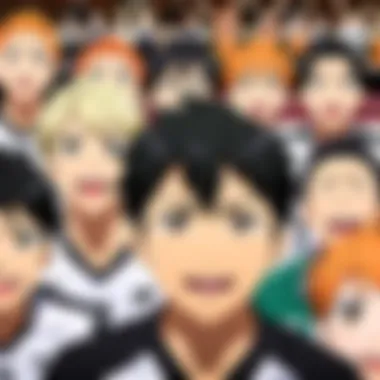A Deep Dive into Haikyuu Dub on Hulu


Intro
In the vast landscape of streaming platforms, Hulu stands out with its diverse selection of content, particularly for anime enthusiasts. Among the treasures available is Haikyuu!!, a series that has captured the hearts of many across the globe. This volleyball-themed anime not only showcases thrilling matches but also dives deep into character complexities and emotional tales. For fans, the dub on Hulu presents an opportunity to experience the series in a different light, enriching their understanding and enjoyment.
Dubbed anime often finds itself at the crossroads of acceptance and criticism, with fervent advocates on either side of the debate. Some argue that the original Japanese voice acting captures the essence better, while others appreciate the accessibility provided by quality dubs. In essence, this article aims to unravel the layers of the Haikyuu!! dub available on Hulu, exploring its production quality, voice cast, and the dynamics of audience reception in a cultural context.
As we navigate through the realms of Haikyuu!!, we will dissect its characters, arcs, and the subtleties that the dubbed version brings to the table. From insightful episode reviews to character spotlights, this comprehensive guide stands to illuminate significant aspects that are often overlooked. It’s crucial to assess how the dubbed series not only retains the magic of its source material but also how it thrives in a competitive anime streaming environment. Let’s embark on this journey, beginning with a look at the episodes themselves.
Foreword to Haikyuu
In a world where anime has transcended borders, Haikyuu!! emerges not just as an entertaining sports series but as a cultural phenomenon. Understanding this series is essential for any anime aficionado or casual viewer alike, especially in the context of its dubbed version available on Hulu. This section serves as a gateway to appreciate its charm and significance in anime culture.
Overview of Haikyuu
Haikyuu!! tells the story of a high school volleyball team, centering on the journey of Shoyo Hinata, a boy who, despite his short stature, has an unyielding passion for the sport. The series, adapted from Haruichi Furudate’s manga, combines the thrill of competition with nuanced character development, making it a compelling watch. It's not merely a tale of winning games but about the growth of individuals as they tackle challenges, both on and off the court.
Each character, from the determined Hinata to the strategic Tobio Kageyama, brings a unique flavor to the story, echoing real struggles and victories that resonate with many viewers.
Significance in Anime Culture
The impact of Haikyuu!! on anime culture is immense. It shines a spotlight on teamwork and determination, aligning perfectly with values embraced by various sports communities.
- Inspires Collaboration: Its portrayal of teamwork acts as a reminder that success often comes from collective effort.
- Breaks Stereotypes: The series transcends traditional athletic tropes, emphasizing that strength is not solely physical.
- Cultural Exchange: With the dubbed version on Hulu, Haikyuu!! has expanded its reach, welcoming a broader audience that might find the subtitled version challenging due to language barriers.
"Haikyuu!! has shown us that it's not about how tall you are, but how high you can jump in spirit."
In the grand scheme of anime, Haikyuu!! redefines what it means to be a sports anime, blending humor, heart, and profound life lessons, thereby carving a niche for itself among the giants of the genre. With such a rich narrative, it encourages viewers to delve deeper into each character's evolution and the dynamics within the team, making for a rewarding viewing experience.
Understanding Dubbed Anime
Anime dubbing is an important topic for our discussion as it directly impacts how viewers connect with the animated narratives. Dubbing transforms content from one language to another, allowing a wider audience to enjoy the story without the barrier of subtitles. This process is crucial for the accessibility of titles like Haikyuu, especially for those who might find reading subtitles distracting or difficult.
What is Anime Dubbing?
Anime dubbing refers to replacing the original voice performances in an anime with new recordings in another language. In essence, it aims to capture the emotions and nuances of the original performances while making it understandable for non-native speakers. This involves carefully syncing the new dialogue with the characters' lip movements—an endeavor that demands skill and attention to detail. For instance, in Haikyuu, each character's voice needs to reflect not only their personality but also their cultural background and emotional state.
Benefits of Watching Dubs
Dubs offer a variety of advantages that can enhance the viewing experience for many audiences. Here are some key points:
- Ease of Understanding: Dubbing eliminates the need for constant reading, allowing viewers to focus on the visuals and action.
- Character Connection: A well-executed dub can foster stronger emotional connections with characters, as viewers can hear them speak in a relatable manner.
- Quality of Performance: With talented voice actors bringing the characters to life, a good dub can sometimes provide a more engaging experience compared to subtitles, particularly for those unfamiliar with Japanese.
Fans of Haikyuu might find that certain dubbed portrayals, like English voices that mirror the intensity of volleyball matches, can enhance their understanding of character motivations.
Challenges in Dubbing


While dubbing can enhance the accessibility of anime, it does face significant challenges that can affect the final product. Some of these include:
- Cultural Nuances: Certain phrases or jokes may not translate effectively into another language, causing a loss of meaning or humor.
- Voice Matching: Finding the right voices to match the original performances can be tricky; mismatched tones or styles might hinder immersion.
- Adaptation Issues: The dialogue needs to adjust to sync with the original animation, which sometimes results in changes that can alter character dynamics or plot meanings.
Ultimately, while dubbing offers vital accessibility to anime like Haikyuu, creators and audiences alike must navigate its complexities to strike a balance between fidelity to the original and cultural adaptation.
Haikyuu Dub on Hulu
The existence of the Haikyuu dub on Hulu holds a significant place in the current anime landscape. Dubbing, with its unique flavor and appeal, broadens the reach of shows like Haikyuu, allowing for a diverse audience to engage with its rich storytelling. The blend of animation and voice performance heightens emotional experiences that resonate with viewers. It’s not just about watching a series; it's about being part of a broader community that engages in discussions surrounding character arcs, sportsmanship, and the very essence of teamwork.
Availability and Access
When it comes to accessibility, Hulu makes it quite simple for viewers to dive into the world of Haikyuu. The dubbed version is available alongside its subtitled counterpart, giving fans the freedom to choose how they wish to experience the series. Whether you're lounging at home or on the go, a subscription to Hulu gets you complete access to all seasons of Haikyuu and its spin-offs, solidifying its role in the realm of sports anime. In addition, with Hulu's streaming capabilities, known for being user-friendly, it’s easy for viewers to catch up on episodes or revisit favorite moments:
- Stream on multiple devices, from smartphones to smart TVs.
- User-friendly interface that allows quick navigation.
- Personalized recommendations based on viewing habits.
This access fosters a community of watchers that often exchanges experiences on platforms like Reddit, encouraging discussions and deeper engagement with the show.
Comparison with Subtitled Version
Diving into the comparison between dubbed and subtitled versions of Haikyuu is essential for understanding viewer choices. While some enthusiasts view subtitles as the authentic experience, many find dubs to be more accessible and enjoyable on a casual level. Dubbing can sometimes bring a different flavor to character interpretation:
- Voice Tone: The emotions conveyed by the actors in the dubbed version might differ from the original Japanese voices. For example, the cheerfulness of Hinata’s character can be amplified through a well-suited English voice actor.
- Pacing: Dubbed versions may adjust the timing of dialogue delivery to match lip movements, which can impact comedic timing and intense moments.
- Cultural Nuances: Dubs may alter certain cultural references for broader understanding, which can also steer character personalities in a different direction.
While subtitles keep the original script intact, dubs can introduce new dimensions, whether through translation choices or voice dynamics. Ultimately, the decision between watching dubbed or subtitled versions of Haikyuu rests on personal taste. Some viewers prefer the natural flow of the dialogue in their native language, while others enjoy the authenticity of the original script. Regardless of your preference, both versions contribute to the evolving nature of anime consumption, ensuring that shows like Haikyuu cater to a wide array of viewers.
Voice Cast Analysis
The voice cast of an anime can make or break the experience for many viewers. In the case of Haikyuu, the talented voice actors bring energy and emotional depth to the characters, making it a notable example in the world of dubbed anime. Understanding the voice cast isn't just about recognizing names; it's about appreciating how their performances contribute to the storytelling and overall impact of the series.
Main Cast Overview
The main cast of Haikyuu is a diverse group of characters, each portrayed uniquely by voice artists who inject life into their roles. Key figures include:
- Ayumu Murase as Shoyo Hinata: His portrayal captures the determination and vast energy of Hinata, the protagonist.
- Kaito Ishikawa as Tobio Kageyama: A voice full of intensity to reflect Kageyama's competitive nature.
- Yūichi Nakamura as Ryunosuke Tanaka: An enthusiastic tone that aligns perfectly with Tanaka’s fierce personality.
These actors don’t just read lines; they embody their characters, creating connections that resonate with viewers. An interesting fact is that some of these voice actors have previously worked in other genres, showcasing their range and versatility. For instance, Ayumu Murase has appeared in various other series, proving his ability to adapt his voice for different emotional contexts.
Voice Acting Techniques
When it comes to the craft of voice acting, Haikyuu sets a solid standard. Voice actors utilize various techniques, such as:
- Emotional Nuance: The subtle shifts in tone highlight character development. For example, the shift in Hinata’s confidence as the series progresses is aptly matched by Murase's evolving vocal performance.
- Character Consistency: Actors maintain consistency throughout the series, ensuring that the audience has a cohesive understanding of who each character is. This becomes vital as viewers grow attached to their nuances.
- Dynamic Range: The ability to shift from comedic moments to serious conflicts is crucial. This is evident in how Kageyama interacts with teammates and rivals alike; his voice reflects various emotional states that enhance the narrative.
These techniques are not merely artistic choices; they are essential for building an immersive experience. When viewers hear these voices, they’re reminded of the characters’ personalities, making every match feel alive.


Audience Reception of Voice Performances
The reception of the voice cast has been largely positive, with many viewers praising their performances. Comments across various platforms often highlight specific scenes where the voice acting excelled. For instance:
"Murase’s delivery really made me feel Hinata’s struggle and triumph. It was raw and real!"
Forums and anime communities frequently engage in discussions comparing the dubbed performances to their original counterparts. While some viewers might have preferences, most agree that the cast has done justice to the characters’ original essence.
- Reception Highlights:
- Nostalgia and Impact: Fans often express nostalgia when revisiting the dubbed series, saying how the voices bring back key memories of the storyline.
- Cultural Context: Many Western fans are able to appreciate the series in a way that resonates with their cultural background thanks to the localized performance.
Production Quality and Adaptation
Production quality and adaptation are pivotal elements in the success and appeal of any anime series. In the case of Haikyuu, these facets not only contribute to the series’ overall enjoyment but also engage its audience on a deeper level. The blend of superior animation, sound design, and effective storytelling makes it stand out among its peers in the anime domain. This section dives into how production quality plays a crucial role in the audience experience and how adaptation choices can affect viewer perception.
Animation Quality and Style
The animation quality in Haikyuu is nothing short of exceptional. From the fluid motion of characters to the intricacies of the volleyball matches, the animation team has crafted visuals that resonate beautifully with the fast-paced action. The character designs are thoughtfully created, capturing both the essence of youth and the competitive spirit inherent to sports anime.
The style follows a certain dynamism that draws viewers in. Each episode resembles a well-orchestrated dance, where the characters leap into action with unparalleled intensity. Notably, the use of bold colors and smooth transitions showcases not just the sport itself but also the emotions of the characters as they strive for victory.
- Attention to Movement: Every serve and spike is carefully animated, allowing fans to feel the thrill of the game.
- Artistic Choices: The designers use distinct visual motifs to represent characters’ emotional states, enhancing the storytelling further.
A more subtle yet significant aspect involves the backgrounds. They’re not mere afterthoughts; the settings evolve alongside the characters, reflecting the change in their journeys. This thoughtful production quality functions as an unseen character, gracefully framing the narrative.
"In every frame, the animator’s dedication shines through—creating a world where emotions and actions collide in spectacular fashion."
Music and Sound Design
Sound plays a critical role in establishing the mood and enhancing the overall experience of Haikyuu. Music and sound design work hand in hand, creating a rich auditory landscape that complements the visual storytelling. The series features a diverse soundtrack that underscores the emotional arcs of each episode.
The choice of music reflects the high-energy atmosphere of volleyball matches while also providing quieter moments for character development. From uplifting themes during crucial game points to more somber notes during character introspection, the musical score is skillfully tailored to match the pace of the narrative.
Additionally, the sound effects are meticulously crafted to provide an immersive experience. The thud of the volleyball, the cheering crowd, and even the characters' voices add layers of depth to each scene.
- Emotional Resonance: Music cues effectively transition scenes and evoke emotional responses, vital for drawing viewers into the story.
- Atmospheric Engagement: Sound design captures the essence of a live volleyball match and the camaraderie between characters, making the audience feel present in each setting.
Cultural Impact of Haikyuu
When we discuss the cultural impact of Haikyuu, it's easy to get lost in the thrilling matches and cartoonish escapades of the characters. However, the show goes deeper than just volleyball – it’s a reflection of teamwork and personal growth that resonates on multiple levels. This section explores why Haikyuu isn’t merely a sports anime but a cultural phenomenon that has touched the hearts of many.
Themes of Teamwork and Perseverance
In Haikyuu, the significance of teamwork is woven intricately into the narrative. Every episode presents a lesson not just about volleyball skills but about collaboration. The various characters, each with unique talents and flaws, learn to work together to face their obstacles, both on and off the court. Viewers often find themselves rooting for not just individuals but a cohesive unit, which is incredibly engaging.


- Developing Relationships: The series emphasizes that individual growth is often tied to group dynamics. For instance, protagonists like Shoyo Hinata and Tobio Kageyama start as rivals but end up forging a compelling partnership. Their evolving relationship is a testament to how trust and understanding build strong teams.
- Overcoming Challenges: Each arc elegantly demonstrates that setbacks are a part of the journey. For instance, when Karasuno faces defeat, it isn’t just about losing a game; it’s about learning from mistakes and coming back stronger. This narrative reinforces the notion that perseverance pays off, a message that resonates with audiences gathered around their screens.
This theme of teamwork extends beyond volleyball, echoing in real-life scenarios where cooperation is vital. It encourages viewers to reflect on their own interpersonal dynamics, challenge their viewpoints, and realize that the strength of a team can surpass individual capabilities.
Character Development and Arcs
Another pillar of Haikyuu’s cultural impact is the depth of its character development. The show offers rich arcs that explore themes of resilience and growth. Each character brings a different background and personal struggle to the table, creating a tapestry of interconnected stories.
- Dynamic Characters: Characters like Daichi Sawamura and Yu Nishinoya aren’t simply side characters; they embody various aspects of leadership and support. Their journeys showcase the importance of different roles within a team. Interestingly, a character who might seem less significant at first often reveals a profound impact when the story unfolds.
- Real-Life Relatability: As viewers follow Hinata's relentless ambition against towering opponents or Kageyama's struggle with his temper, they find pieces of themselves reflected in these characters. The growth that characters undergo is relatable and raw, making them feel more like friends than fictitious figures.
Viewer Demographics and Trends
The exploration of viewer demographics and trends in the context of the Haikyuu dub on Hulu sheds light on who is engaging with this beloved series. Understanding who watches the dub and how they interact with the show can provide valuable insights for content creators, marketers, and fans alike.
Audience Engagement with the Dub
The engagement levels of the audience with the Haikyuu dub reveal much about the factors influencing their choice of watching the dubbed version over the original subtitled format. Far from being merely a matter of convenience, dubbed anime tends to appeal to a diverse audience, including those who may not be as comfortable reading subtitles.
For instance, younger viewers, like teenagers, often prefer the dub because it allows them to multitask, such as browsing social media or doing homework, without being glued to reading. Moreover, the influence of peers can't be ignored; the shared experience of watching a show together in English fosters discussion and community engagement among friends. This trend reflects a broader shift in anime consumption, where accessibility and community interactions play a significant role.
- Online Communities: Platforms like Reddit and Facebook have groups dedicated to fans sharing their thoughts on episodes, characters, and voice performances.
- Social Media: Fan art and memes, particularly on Instagram and Twitter, emphasize key moments from the dubbed series, enhancing community ties and luring more viewers.
Comparative Analysis with Other Series
When looking at how Haikyuu's dub stacks up against other anime dubs, it becomes clear that several series have forged different paths regarding demographic appeal and audience engagement. Notable comparisons can be made with shows like My Hero Academia and Attack on Titan, each attracting a varied viewer base based on themes, storytelling, and character depth.
- Character Development: Viewers often gravitate towards series that offer compelling character arcs. While Haikyuu focuses on sports and teamwork, series like My Hero Academia resonate because of their unique take on heroism.
- Soundtrack and Voice Acting: The quality of the dub's voice actors is pivotal. The dub of Haikyuu has been praised for its fit and characterization, rivaling that of major titles known for outstanding performances like Cowboy Bebop or Demon Slayer.
Analyzing viewer trends can reveal distinct character on major streaming platforms. While in-depth themes in shows like Attack on Titan might attract a slightly older demographic, Haikyuu appeals more to the youthful crowd thanks to its themes of perseverance, friendship, and the sports genre. This division of viewership is critical; it highlights how different narrative styles inform viewer preferences, thus painting a broader picture of anime's evolving landscape.
In summary, examining the audience trends surrounding Haikyuu’s dub and comparing it with other popular series helps clarify why it continues to engage a substantial fanbase and how it fits within the larger cultural narrative of anime consumption.
Finale and Future Perspectives
Summarizing the journey of the Haikyuu dub on Hulu requires reflection on its multifaceted impact within the anime industry and its community. The series stands as a testament to storytelling done right, combining dynamic sports action with emotional depth. One of the key elements that have been touched upon throughout this exploration is how Haikyuu resonates with various demographics, demonstrating its broad appeal beyond traditional anime viewers. This dialogue about the series isn't merely a reflection on its artistic merit; it speaks volumes about current trends in streaming platforms, viewer preferences, and the general evolution of anime consumption.
Summarizing Key Insights
Several points come to mind when discussing Haikyuu's dub:
- Voice Acting: The cast has been praised not just for their skills but for their ability to capture the essence of their characters. Each voice actor contributes uniquely to the narrative's emotional core, bringing scenes to life in a way that perhaps only a well-timed shrug or a proud shout could.
- Production Quality: Animated series often face scrutiny regarding visual appeal. Haikyuu has managed to deliver quality animation that complements the high-energy volleyball sequences. This, coupled with impressive sound design, creates a rich audiovisual experience.
- Cultural Relevance: The themes explored in the series—teamwork, friendship, and determination—find a universal audience. As evident in the vibrant discussions across various platforms, such as reddit.com, fans find personal connections to the characters and their struggles.
Overall, Haikyuu serves as a landmark series that highlights how anime can effectively engage both fans of the genre and newcomers alike.
The Future of Dubbing in Anime
Looking ahead, the future of dubbing in anime seems poised for a more prominent role in the industry. First off, technological advancements have paved the way for more seamless dubbing experiences, lessening the gaps that once existed between the original and localized versions. Machine learning and AI are improving timing and linguistic nuance, ensuring that dubs come closer than ever to reflecting the original performance.
Moreover, with streaming platforms like Hulu increasingly embracing dubbed content, we can expect an expanded library that aims to cater to diverse tastes. The audience is growing more discerning, asking for content that reflects not just a translation of dialogue but a cultural adaptation as well. Hence, studios might need to consider home-grown talent who understand the local context, tapping into the nuances that resonate with Western audiences.
In a world where visual storytelling continues to flourish, the evolution of dubbing will be pivotal. Audiences will demand not just stories but authentic portrayals that maintain the spirit of the original while being relatable in their cultural context. It’s an exciting time for dubbed anime, where the infusion of diverse voices and perspectives can breathe new life into beloved series, turning every viewing into a shared experience.







